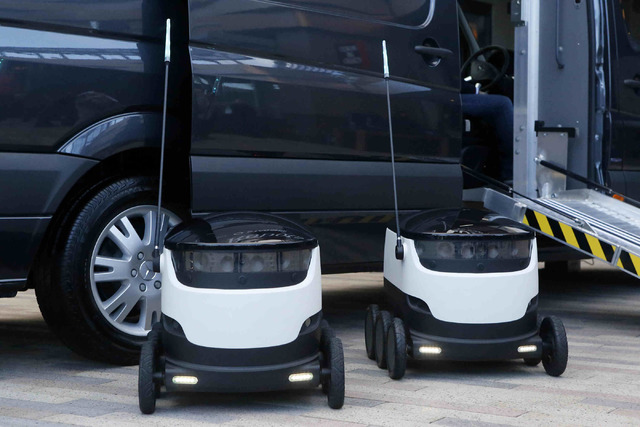Droids deployed by a delivery van could step up in parcel deliveries

An armada of self-driving, camping-cooler-looking droids deployed by a delivery van could be the next big step in parcel deliveries.
Luxury car company Mercedes-Benz has partnered with European robotics company Starship Technologies in an effort to streamline and simplify the last mile of package delivery logistics, which the companies say is the most cumbersome step in current deliveries. The hope, according to Starship marketing and communications manager Henry Harris-Burland, is to give consumers an on-demand delivery mechanism to ensure a consumer never misses a delivery at little cost.
“Convenience and cost efficiency are the two key drivers in our design,” Harris-Burland said during a pre-CES demonstration of the product Wednesday at Downtown Summerlin.
The process would start with the consumer. Say a person needs a new laptop. The consumer orders it and uses a smartphone app to select a specific time they want the computer delivered to their home, office, etc.
From there, the vans head to the store, pick up the item and head out to deploy its fleet of droids from a central hub area decided by the van’s delivery program.
The vans themselves are tricked out with a program that highlights containers to ensure that the correct parcel goes into the right droid. After that, the driver simply hits the “dispatch” button on a tablet, and the six-wheeled droid is off and running (relatively speaking) on neighborhood sidewalks en route to the consumer’s house, while the driver works on loading the up the next droid for a nearby delivery destination.
The droid uses nine cameras to produce a 3-D image of its surroundings to avoid trees and other obstacles while it autonomously traverses city sidewalks at around 4 mph, according to Starship.
After the robot makes its delivery, it heads to a pre-determined pick zone that effectively acts as a bus stop for the droid convoy as it waits for the van to pick it up.
Each droid can carry about 20 pounds worth of products or groceries, but the order would have to fit into the tub-sized bin as well.
The company hopes to be able to provide products within 60 minutes of the order being placed, and it plans to charge $1 per delivery.
But the nature of self-driving delivery droids presents a unique concern for deliverers: A slow-moving, ground-bound droid might seem like an easy target to potential thieves looking to snag a high-end electronic before it reaches its destination.
The droids are equipped with several features Starship hopes will combat that, Harris-Burland said.
They weigh about 35 pounds and have an electronic lock to keep the cargo lid shut tight. Should someone decide to simply run off with the robot, an ear-piercing siren is triggered, and the robot can be tracked via GPS.
Still, like with other deliveries, Harris-Burland said avoiding all thefts is highly unlikely.
“It will happen. It’s impossible to prevent,” he said.
The droid system from Mercedes and Starship could end up being direct competition for Amazon’s airborne drone delivery system as they seemingly push the current-day standard of a large delivery truck going house to house into retirement. But both options are works in progress, and it could be several years before either becomes widely availalble.
Amazon says its Prime Air, which is still in the preliminary testing phases, will be able to deliver packages that weigh less than five pounds to consumers in under 30 minutes. Because they are airborne, Amazon will have to wrangle with the added airspace regulations that aren’t yet fully ironed out for the drone world.
As for when consumers could see Starship delivery droids rolling down their streets, Harris-Burland didn’t give a hard deadline for when the robots could be commercially viable.
The company will start wide-scale testing in Germany this year, but smaller-scale test runs have been underway in 58 cities across 16 countries, including Washington, D.C., and Redwood City, California. But the system needs more strenuous real-world testing before it becomes commercially viable, he added.
So if you see one of these droids rolling down your neighborhood street some time in the next few years, don’t panic. It’s not a droid invasion. It might just be your groceries.
Contact Colton Lochhead at clochhead@reviewjournal.com or 702-383-4638. Follow @ColtonLochhead on Twitter.